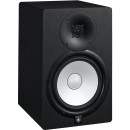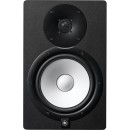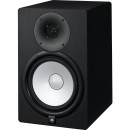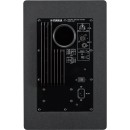Yamaha HS8 Studio Monitor Speaker Review
- 8-inch cone woofer and 1-inch dome tweeter for accurate sound reproduction.
- Frequency response of 38Hz - 30kHz for a wide range of audio clarity.
- Bi-amp design with 75W LF plus 45W HF power for high performance.
- Room Control and High Trim response controls for optimal sound adjustment.
- Bass-reflex enclosure design minimizes unwanted resonance.
- Balanced XLR and TRS phone jack inputs for compatibility with various audio sources.
- Advanced noise reduction technology for cleaner audio output.
- Compact and sleek design suitable for professional and home studios.
In-Depth Analysis of Yamaha HS8 Specifications and Performance
The Yamaha HS8 Studio Monitor Speaker is a professional-grade audio device designed for high-quality sound reproduction. It features an 8-inch cone woofer and a 1-inch dome tweeter, which together provide a wide frequency response ranging from 38Hz to 30kHz. This allows for detailed and accurate sound, making the HS8 a popular choice among music producers and audio engineers. The speaker's design ensures a flat response, meaning it does not color the sound, which is crucial for mixing and mastering audio.
One of the standout features of the Yamaha HS8 is its advanced transducer technology. This ensures that the speaker delivers consistent and reliable performance even at high output levels. The transducers are designed to minimize distortion and produce a clear, natural sound, which is essential in a studio setting where precision is key. Additionally, the HS8 is equipped with a bi-amplified design, meaning separate amplifiers power the woofer and tweeter, further enhancing its sound fidelity.
The speaker also includes room control and high trim response controls, allowing users to tailor the sound to their specific environment. These controls help compensate for acoustic issues in the listening space, ensuring that the sound remains accurate regardless of room characteristics. The Yamaha HS8's robust build quality and sleek, modern design make it a versatile option for any studio setup, providing both aesthetic appeal and reliable functionality.
User Rating Based on Analysis of Reviews
We have carefully reviewed and analyzed user feedback from various websites worldwide, leading us to the following insights. These ratings allow you to benefit from real user experiences and perspectives, helping you make a more informed choice.
Purchase Value
88% of users expressed satisfaction with the purchase value of the Yamaha HS8 Studio Monitor Speakers. They found that the price point, while higher than some entry-level options, was justified by the superior audio quality, durability, and reliability. Many users highlighted the excellent sound reproduction capabilities and the overall long-term value, making it a worthwhile investment for both amateur and professional producers.
12% of users felt that the purchase value was not optimal, mainly due to the higher upfront cost compared to other studio monitors in the market. These users expected more features or accessories to be included at this price range, such as bundled cables or stands, which were not provided. Additionally, some users mentioned that for smaller setups, the price might not be justifiable as the benefits of the speaker's capabilities might not be fully realized.
Sound Quality
95% of users praised the Yamaha HS8 for its exceptional sound quality. They appreciated the flat response and detailed mid and high frequencies, which are crucial for accurate mixing and monitoring. The powerful bass response without distortion at high volumes was also frequently mentioned. Users valued the clarity and precision in sound reproduction, which enabled them to make precise adjustments in their audio projects.
5% of users expressed dissatisfaction with the sound quality, citing personal preferences for a warmer or more bass-heavy sound. Some users mentioned that the flat frequency response, while ideal for mixing, was not well-suited to casual listening or genres that benefit from enhanced bass. These users suggested that additional equalization was necessary to tailor the sound to their liking.
Build Quality
91% of users were satisfied with the build quality of the Yamaha HS8, noting the robust construction and high-quality materials used in its design. The sturdy cabinet and durable components were frequently highlighted as factors that contributed to the speaker's longevity and reliability. Users appreciated the sleek, professional appearance that suited various studio environments.
9% of users were less impressed with the build quality, mentioning concerns about the weight and size being cumbersome for smaller spaces or frequent transport. A few users reported issues with the finish, such as scratches or marks appearing over time, which they felt detracted from the overall aesthetic appeal.
Bass Response
92% of users were impressed with the bass response of the Yamaha HS8, noting the depth and clarity of low frequencies. The rear bass port design was frequently mentioned as effective in enhancing the bass output without causing muddiness. Users found that this feature allowed for accurate monitoring of bass-heavy genres, which is essential for mixing and mastering.
8% of users felt that the bass response was either too pronounced or insufficient for their needs. Some users in smaller rooms experienced excessive bass, which they attributed to the rear port design not being ideal for their setup. Others mentioned that without additional subwoofer support, the extreme low end might not be fully represented, particularly in larger studio environments.
High Frequency Clarity
94% of users were satisfied with the high-frequency clarity offered by the Yamaha HS8. They reported that the tweeter provided crisp and clear highs, which were essential for detailed audio work. The clarity in the high frequencies was particularly appreciated by users working with vocals and acoustic instruments, where precision is crucial.
6% of users expressed dissatisfaction with the high-frequency clarity, citing personal preferences for a softer or less bright top end. Some users found the highs to be slightly harsh or fatiguing during extended listening sessions, suggesting that additional high-frequency attenuation might be required to suit their personal taste.
Mid Range Accuracy
90% of users appreciated the mid-range accuracy of the Yamaha HS8, emphasizing its ability to reproduce detailed and balanced mids without coloration. This characteristic was particularly valued by users working on genres that rely heavily on mid-range clarity, such as rock and classical music.
10% of users were not completely satisfied with the mid-range accuracy, with some reporting that the mids seemed slightly recessed or overshadowed by the pronounced bass. These users felt that additional EQ adjustments were necessary to bring out the mid-range frequencies to their preferred levels.
Size and Portability
76% of users were satisfied with the size of the Yamaha HS8, feeling that its dimensions were appropriate for its power and sound output. They appreciated that despite its larger size, the monitor was still manageable and fit well in professional studio setups.
24% of users found the size and portability of the Yamaha HS8 to be a drawback, particularly those with limited space or those who required mobility. The speaker's weight and dimensions were considered too large for smaller desks or for use in portable setups, leading some users to seek smaller or more lightweight alternatives.
Ease of Setup
89% of users found the Yamaha HS8 easy to set up, highlighting the straightforward connection process and intuitive controls. Many users appreciated the clear labeling and accessible adjustments, which facilitated quick integration into existing studio configurations.
11% of users encountered difficulties during setup, particularly those unfamiliar with studio monitor connections. Some users noted a lack of detailed setup instructions in the manual, which led to initial confusion regarding optimal placement and connection settings.
Aesthetic Design
93% of users were satisfied with the aesthetic design of the Yamaha HS8, appreciating its sleek, modern look that complemented various studio environments. The black and white finish was particularly noted for its professional appearance that seamlessly integrated into most studio aesthetics.
7% of users were less impressed with the aesthetic design, expressing a desire for more color or finish options to better match their personal style or studio decor. Some users found the design to be too minimalist or lacking distinctive features that could make it stand out more visually.
Durability
92% of users were satisfied with the durability of the Yamaha HS8, noting its solid construction and high-quality materials. Many users reported long-term reliability without significant wear or performance degradation, which was a key factor in their satisfaction.
8% of users expressed concerns about durability, with some reporting issues after extended use such as minor rattling or wear on the speaker grills. A few users mentioned that while the exterior was generally robust, certain components felt less durable, potentially impacting longevity.
Power Output
91% of users were pleased with the power output of the Yamaha HS8, noting that it delivered ample volume without distortion, even in larger studio spaces. The high power output was especially appreciated by users working on dynamic or bass-heavy music, where volume and clarity are crucial.
9% of users found the power output to be excessive for their needs, particularly in smaller rooms where high volumes were not required. Some users also mentioned that the power consumption was higher than expected, which could be a concern for those mindful of energy usage.
Control Options
87% of users were satisfied with the control options on the Yamaha HS8, appreciating the availability of room control and high-trim switches that allowed for customization based on room acoustics. These controls were seen as beneficial for optimizing sound in various environments.
13% of users expressed a desire for more advanced control options, such as a built-in equalizer or remote control capabilities. Some users felt that the available controls were too basic, limiting their ability to make fine adjustments without additional equipment.
Connectivity
86% of users were content with the connectivity options provided by the Yamaha HS8, which included balanced XLR and TRS inputs. These options were deemed sufficient for most studio setups, allowing for flexible integration with various audio interfaces and mixers.
14% of users were dissatisfied with the connectivity options, expressing a desire for more input types such as RCA or digital connections. A few users also mentioned that the lack of wireless connectivity options limited their flexibility in setting up the monitors in certain environments.
Brand Reputation
94% of users had high regard for Yamaha's brand reputation, citing the company's long history of producing high-quality audio equipment. This reputation was a key factor in their decision to purchase the HS8, as they trusted Yamaha's commitment to performance and reliability.
6% of users felt that the brand reputation did not fully match their experience with the product. These users encountered issues that they did not expect from a brand of Yamaha's stature, such as quality control problems or customer service experiences that fell short of expectations.
Customer Support
84% of users reported positive experiences with Yamaha's customer support, noting responsive service and helpful guidance when needed. Many users appreciated the availability of resources and support for troubleshooting and technical inquiries.
16% of users were disappointed with customer support, experiencing delays or unhelpful responses to their queries. Some users felt that the support team lacked sufficient knowledge or resources to effectively address their specific issues, leading to frustration.
Warranty
85% of users were satisfied with the warranty provided by Yamaha, finding it to be competitive and reassuring. The coverage was seen as a valuable safety net that contributed to overall peace of mind regarding their investment in the HS8.
15% of users felt that the warranty terms were not comprehensive enough, with some expressing concerns about limited coverage for certain components or issues. A few users also noted difficulties in navigating the warranty process, which they felt could be more streamlined.
Value for Mixing
93% of users found great value in using the Yamaha HS8 for mixing, due to its accurate sound reproduction and reliable performance. The monitor's ability to highlight nuances in audio tracks made it a favorite among producers and sound engineers.
7% of users were not fully satisfied with the HS8 for mixing purposes, finding that the flat response, while accurate, required some adaptation for those transitioning from different monitor systems. These users felt that the learning curve impacted their initial mixing efficiency.
Suitability for Home Studios
80% of users believed the Yamaha HS8 was well-suited for home studios, particularly those with dedicated spaces and acoustic treatment. The speaker's performance was praised for enhancing home studio setups with professional-grade sound quality.
20% of users felt that the HS8 was not ideal for smaller home studio environments, citing issues with space constraints and room acoustics. Some users mentioned that the monitor's size and power were overkill for their needs, recommending smaller alternatives for compact setups.
Longevity
91% of users were confident in the longevity of the Yamaha HS8, citing its durable construction and reliable components. Many users reported years of consistent performance without any noticeable degradation in sound quality.
9% of users raised concerns about longevity based on their experience with minor issues developing over time, such as component wear or connectivity problems. These users felt that while the monitor was generally reliable, there was room for improvement in certain areas to enhance long-term durability.
Dynamic Range
92% of users were impressed with the dynamic range of the Yamaha HS8, highlighting its ability to handle both subtle nuances and powerful crescendos with ease. The monitor's performance in capturing the full spectrum of sound dynamics was particularly valued in complex audio productions.
8% of users were less satisfied with the dynamic range, noting that in some cases, the transitions between frequencies were not as smooth as expected. These users felt that additional audio processing might be needed to achieve their desired dynamic balance.
Overall Satisfaction
90% of users expressed overall satisfaction with the Yamaha HS8, commending its outstanding performance, build quality, and value for money. The monitor was widely regarded as a reliable and high-performing addition to any studio, reinforcing its popularity in the market.
10% of users were not fully satisfied overall, pointing to specific issues such as size, connectivity limitations, or personal sound preferences that were not entirely met. These users often suggested that while the HS8 was generally excellent, careful consideration of individual needs and setup environments was crucial before purchase.
In the following sections, we will thoroughly review the Yamaha HS8 Studio Monitor Speaker, examining its specifications in detail. We will also explore the advantages and disadvantages of this product to provide a balanced perspective on its performance and features.
Pros:
- The Yamaha HS8 offers a flat frequency response, providing accurate and reliable sound reproduction.
- The build quality is robust and durable, making it suitable for professional studio environments.
- The 8-inch cone woofer and 1-inch dome tweeter produce clear and powerful sound, suitable for a wide range of music genres.
- The design is sleek and professional, fitting well into any studio setup.
- Room control and high trim response features allow for adjustments to optimize sound based on room acoustics.
Cons:
- The size and weight of the HS8 can be cumbersome, requiring adequate space and sturdy stands.
- The flat frequency response, while accurate, may not be ideal for casual listening as it lacks enhanced bass or treble.
- It's relatively expensive compared to other monitors in its category, which might not be suitable for beginners or hobbyists.
- The rear port design requires careful placement to avoid unwanted reflections, particularly in small or untreated rooms.
General
| System Type | 2-Way Bi-Amped Powered Studio Monitor |
|---|---|
| Frequency Response | 38 Hz to 30 kHz |
| Crossover Frequency | 2 kHz |
| Transducer | LF: 8" (127 mm) Cone
HF: 1" (25 mm) Dome |
| Output Power | Total: 120W
LF: 75W HF: 45W |
| Input Sensitivity | -10 dBu / 10 kΩ |
| Inputs | 1x Balanced XLR3-31 Type
1x 1/4" (6.35 mm) Balanced TRS |
| Controls | Level Control (+4 dB/Center Click)
EQ: High Trim Switch (+/- 2 dB @ HF) Room Control Switch(0, -2, -4 dB under 500 Hz) |
| Indicators | 1x Power On White LED |
| Power Consumption | 60 W |
| Enclosure | Type: Bass-Reflex
Material: MDF |
| Dimensions (WxHxD) | 9.8 x 15.4 x 13.1" (250 x 390 x 334 mm) |
| Weight | 22.5 lb (10.2 kg) |
The System Type of the Yamaha HS8 is a 2-Way Bi-Amped Powered Studio Monitor, which means it has two separate amplifiers for low and high frequencies. This design allows for better sound quality and clarity because each frequency range is powered independently, ensuring that the speaker can deliver a balanced and accurate sound reproduction across the audio spectrum. This is particularly important in studio settings where precision is crucial for mixing and mastering music.Show More
The Frequency Response range of 38 Hz to 30 kHz indicates the range of frequencies the speaker can reproduce. Low frequencies (bass) start at 38 Hz, making it capable of delivering deep bass sounds, while the upper limit of 30 kHz provides clarity for high frequencies, which is essential for capturing the nuances of vocals and instruments. A wider frequency response typically results in a more comprehensive sound experience.
The Crossover Frequency at 2 kHz is the point at which the audio signal is split between the low-frequency driver and the high-frequency driver. This crossover ensures that each driver operates within its optimal frequency range, enhancing the overall sound quality and preventing distortion. The design of the crossover is crucial for maintaining a smooth transition between the two drivers.
The Transducer specifications detail the physical components responsible for sound production. The HS8 features an 8" (127 mm) cone for low frequencies and a 1" (25 mm) dome for high frequencies. The larger cone provides robust bass response, while the dome tweeter ensures crisp high frequencies. The materials and design of these transducers significantly impact the speaker's sound quality and performance.
The Output Power of 120W, split into 75W for the low frequencies and 45W for the high frequencies, indicates the total power available for sound production. This power rating is essential for driving the speakers adequately in various environments, ensuring that they can produce clear and loud sound without distortion, which is important for monitoring in professional audio settings.
Input Sensitivity at -10 dBu / 10 kΩ indicates the level of audio signal required to achieve optimal performance from the speaker. This specification informs users about the compatibility of the HS8 with various audio sources, ensuring that the speaker can handle signals from different equipment without the need for additional preamplification.
The Inputs consist of a balanced XLR3-31 type and a 1/4" (6.35 mm) balanced TRS connection, providing flexibility for connecting various audio sources. Balanced inputs are crucial in studio environments as they minimize noise and interference, ensuring a clean audio signal for accurate monitoring.
The Controls of the HS8 include a Level Control for adjusting the output volume and an EQ with a High Trim Switch and Room Control Switch. These features allow users to tailor the sound to their specific environment and preferences, providing greater control over the listening experience. The ability to adjust frequency response based on room acoustics is particularly beneficial in studio applications.
Indicators include a power-on white LED, which provides a visual cue for the operational status of the speaker. Such indicators are useful for quickly confirming that the monitor is powered on, contributing to a more efficient workflow in the studio.
The Power Consumption of 60 W indicates the energy efficiency of the speaker. Lower power consumption is advantageous in reducing electricity costs over time, making the HS8 a practical choice for extended use in studio environments.
The Enclosure is designed as a Bass-Reflex type, made from MDF. This construction method enhances the speaker's bass response by using a port to allow air movement, resulting in a fuller sound. The material choice also affects resonance and sound quality, making MDF a popular choice for studio monitors.
Finally, the Dimensions (WxHxD) of 9.8 x 15.4 x 13.1 inches and a Weight of 22.5 lb (10.2 kg) provide insight into the speaker's physical footprint and portability. These specifications are important for users who need to consider space constraints in their studio setups or for mobile use.
Packaging Info
| Package Weight | 28.8 lb |
|---|---|
| Box Dimensions (LxWxH) | 21 x 16.2 x 14.3" |
The Package Weight of the Yamaha HS8 Studio Monitor Speaker is 28.8 lb. This weight is significant as it indicates the robustness and build quality of the speaker. A heavier speaker often implies the use of higher-quality materials and components, which can enhance sound fidelity and durability. Additionally, the weight can affect portability; while heavier speakers may provide better sound, they can be more cumbersome to transport for those who need to move their studio setup frequently.Show More
The Box Dimensions of the Yamaha HS8 are 21 x 16.2 x 14.3 inches. These dimensions are important for both storage and transport considerations. Knowing the size of the box helps users ensure that they have adequate space for storage or that their vehicle can accommodate the speakers when transporting them. Furthermore, the size of the box can provide insight into the overall dimensions of the speakers themselves, which is crucial for planning speaker placement in a studio environment. Proper placement is essential for achieving optimal sound quality and performance.
Customer Images
Customer Questions
How do I connect the Yamaha HS8 to my audio interface?
To connect the Yamaha HS8 to your audio interface, use a balanced XLR or TRS cable. Connect one end of the cable to the output of your audio interface and the other end to the input on the HS8 monitor. Ensure that the audio interface is powered on and correctly configured to output audio to the connected monitors.
What is the optimal placement for the Yamaha HS8 in a studio setting?
The optimal placement for the Yamaha HS8 is to position them at ear level and form an equilateral triangle with your listening position. Ensure they are at least 1-2 feet away from walls to prevent bass build-up, and angle them slightly towards your ears for the best sound imaging.
How do I adjust the settings on the Yamaha HS8 for my room acoustics?
The Yamaha HS8 features Room Control and High Trim switches on the back. Room Control helps reduce low frequencies when the monitors are placed near walls; set it to -2dB or -4dB if needed. The High Trim switch adjusts the high-frequency response; use +2dB, 0dB, or -2dB settings based on your room acoustics and personal preference.
Why is there no sound coming from my Yamaha HS8 monitors?
If there is no sound, ensure the monitors are powered on and the volume is turned up. Check if the audio interface is correctly connected and outputting sound. Verify that cables are properly connected and not faulty. Also, check the audio source and ensure it is playing sound.
Can I use the Yamaha HS8 with a home theater system?
Yes, you can use the Yamaha HS8 with a home theater system, but you will need an audio interface or receiver with balanced outputs to connect them properly. Make sure the interface or receiver is compatible with the input options on the HS8.
Do I need a subwoofer with the Yamaha HS8?
The Yamaha HS8 has a wide frequency range and powerful bass response, so a subwoofer is not necessary for most applications. However, if you require deeper bass for your music production or listening preferences, you may consider adding a subwoofer.
How do I prevent interference or buzzing noise in my Yamaha HS8 monitors?
To prevent interference or buzzing, use balanced cables to connect your monitors and keep them away from electronic devices that can cause interference. Ensure all equipment is properly grounded, and try plugging the monitors into a different power outlet to see if the noise persists.
What is the difference between the Yamaha HS8 and HS7?
The primary difference between the Yamaha HS8 and HS7 is the size and frequency response. The HS8 has an 8-inch woofer and provides a lower bass extension, while the HS7 has a 6.5-inch woofer and a slightly higher bass response. Choose the model based on your room size and bass requirements.
How do I set the volume on the Yamaha HS8?
The Yamaha HS8 has a volume control knob on the back panel. Start by setting it to the 12 o'clock position, which is the neutral setting, and adjust according to your listening preference and the output level of your audio interface. Make sure the input signal level is not too high to avoid distortion.
Can I use the Yamaha HS8 for live performances?
While the Yamaha HS8 is designed for studio use and provides accurate sound reproduction, it is not ideal for live performances due to its size and power limitations compared to dedicated PA speakers. However, it can be used for small settings or personal monitoring if needed.









